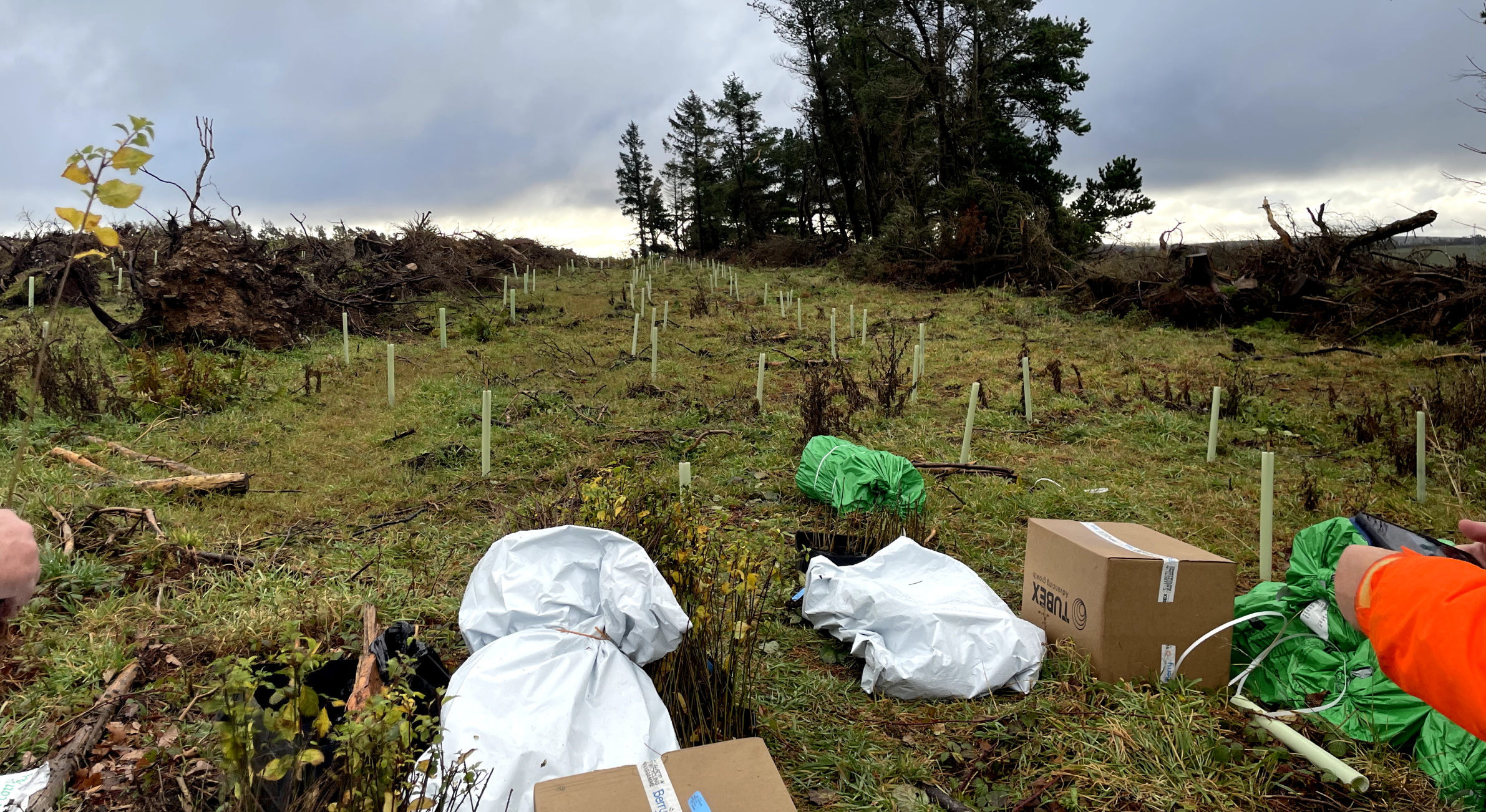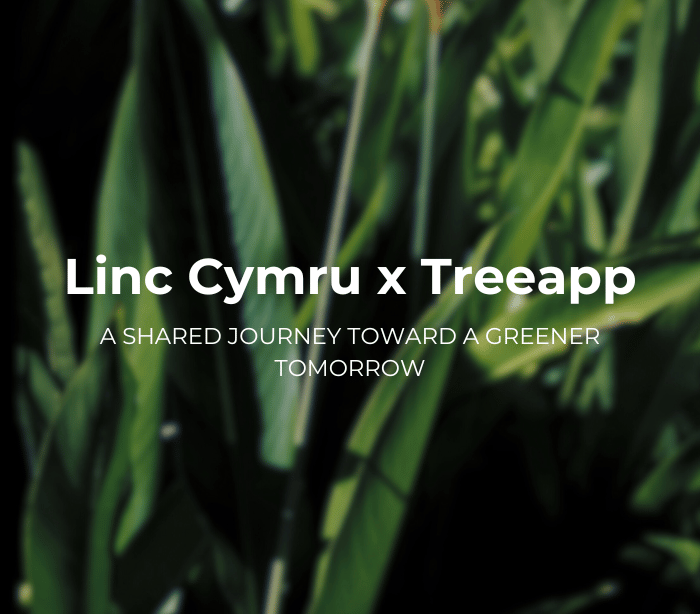Welcome to our reforestation project in Scotland!
The Treeapp team has dedicated a significant time to analyse the current state of forestry across Scotland. It was crucial for us to begin planting in the areas that need it the most in the region. Unfortunately, we have observed many woodland schemes in Scotland that aim solely to receive some kind of carbon credits, providing no benefit to wildlife or biodiversity. While we appreciate the importance of these schemes, we often find that these don’t reach the levels of biodiversity gain and social enhancement that we look after.
As we scoped out areas for planting, many discussions highlighted the importance of restoring damaged or destroyed woodlands—an issue often overlooked. Government grants tend not to provide enough funding for farmers to re-establish woodlands damaged by storms or other natural disasters.
In 2021, Storm Arwen swept through Scotland and severely damaged or destroyed an estimated 16 million trees. Our experts discovered that a significant factor behind this devastation was the incorrect planting of woodlands in the 1970s and 1980s, such as trees being planted too close to each other.
Driven by this discovery, we embarked on a mission to find farmers whose woodlands were affected by the storm and to assist them in restoring native, biodiverse forests.
Thanks to the amazing work of one Scottish Treeapp team member, Charlotte, we started working with landowners looking for support to re-establish their woodland in the region of Berwickshire. Charlotte spoke with multiple farmers in the region - until she met with Ronnie Dale, owner of Whiteburn farm, near the Duns - 1hr away from Edinburgh. When speaking about the storm damages, Ronnie told us:
“Standing here amidst what was once a large forested area, sadly in 2021 Storm Arwen reduced thousands of well-established forested areas, which were used as much needed shelter belts for my stock.”

Ronnie Dale, owner of Whiteburn farm
So, we started to put a plan together to re-establish these felled woodlands. By focusing on suitable species diversity and storm-resistant planting methods, we were committed to creating a resilient future forest. Our efforts went towards sourcing species that support a large range of wildlife. We recorded that 40 bird species in the area, such as Skylark, Robin and Yellowhammer birds could benefit from the newly planted trees.
Putting together a planting plan

November 2023: tree planting day at the site
So how do we go about creating a planting plan?
We start by digitally mapping the plantable areas on the landowner’s plots and then collaborate with the landowner to identify their preferred planting locations.
Then, by using geo-mapping software, satellite imagery and in-person assessments, our team assessed the area and local soil types. For this project, we identified the presence of calcareous and a small portion of mineral gley soils, with variations in texture and drainage capacity.
Calcareous soil, also known as limestone or alkaline soil, contains a lot of calcium carbonate (lime). It forms in areas rich in calcium minerals like limestone and has a high pH. Calcareous soils can differ in texture and composition but share common traits due to their calcium content.
Mineral gleys, also called gley soils, are known for poor drainage and reduced iron compounds. They typically form in areas with poor drainage, leading to waterlogged conditions that affect their characteristics and colour.
When planting trees in these soils, it’s important to choose species that can tolerate high pH and poor drainage.
Another critical consideration in the planning process is the local wildlife, as it dictates the need for tree protection and the appropriate size of the guards. For instance, if large deer roam the area, we usually need to install 1.2 metre tree guards to prevent the animals from eating the trees as they grow.
Choosing tree species

November 2023: different tree species ready for planting
In close collaboration with the local forestry experts and tree nurseries, we can ensure the selection of appropriate native tree species are chosen. Additionally, as we do across all of our UK sites, we worked with a local forester who provides further location-specific insights into the land.
For this project, a diverse mix of trees were used, including hazel, hawthorn, sessile oak, and rowan, all sourced from local, Plant Healthy certified, nurseries. Planting different tree species to create a biodiverse environment is crucial for many reasons, including fostering a wildlife-friendly forest. The diverse range of species creates varied habitats and food sources that support a wide range of animals and insects throughout the year.
DID YOU KNOW? Mature Oak trees can support more than 2,300 animal species, including birds, bats and insects.
The final stage of the planning process is determining the spacing needed between the trees and shrubs. For this project, trees were planted at least 3m apart with shrub species interspaced. This is because shrub species generally grow faster than trees, which provides an early habitat for wildlife and protects the young trees.

November 2023: visiting the planting site with sponsors Wren Kitchens (represented by Trevor Nixon in orange).
All of this work is possible thanks to our generous sponsors who funded an initial 5,588 trees that were planted in Winter 2023/2024: Wren Kitchens , OVO Energy , Direct Line Group , Veolia and many more.
Planting activities and techniques
The planting season in Scotland generally runs from November to April - aligning with the “rainy” season. Trees are planted during these months because the cooler, wetter weather conditions provide an ideal environment for young trees to establish their roots without the stress of heat and drought.
The land is prepared before planting by cutting down dying trees and repurposing them as windbreaks. This is done uniquely for this site, as the trees will then be protected from future storms and strong winds, increasing their survival rate.
We also carefully consider the landowner’s wishes when carrying out the project. This is why, in some sections, the trees are planted in rows, while in other areas, they are scattered. This approach ensures that the project is maximally beneficial for both the landowner and the surrounding environment.

Creating a truly native forest with trees scattered throughout the plot
Ensuring sustainable growth and future collaboration
This reforestation project is particularly exciting for us because of its profound and lasting impact. By collaborating closely with the local stakeholders, we ensured that we plant the right trees in the right places at the right time. Careful planning and coordination enable us to create a resilient, biodiverse woodland that will benefit not only the present ecosystem but also future generations.
We are working closely with Ronnie, the landowner, to keep track of the growth of the trees. We will also support him when the time comes to remove and recycle the tree protectors. This hands-on approach ensures that our reforestation efforts are sustainable and continually monitored. As Ronnie puts it, “their professionalism and due diligence to the project has been a true inspiration”.
“Thanks to Treeapp’s storm-resilient approach to tree planting, we are reforesting more robustly since the devastation of Storm Arwen, which marks a new, resilient beginning for our land.
Due to my age I may not reap the fruits of their labour, however as custodian of this land I am eternally grateful to them, as will be the next generation.”
With many more trees to plant in the region, we would be delighted to welcome further funding to support neighbouring farms in replanting damaged woodlands. Thank you already to our partners ABB , InReach Group , Veolia and more for funding additional tree planting in the area for Winter 2024/2025.
Please get in touch at hello@thetreeapp.org for more information.









